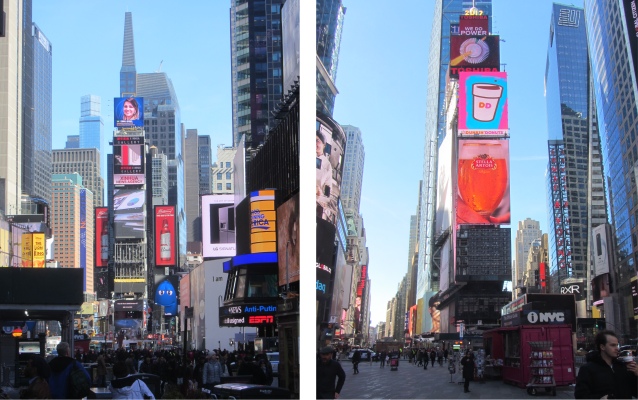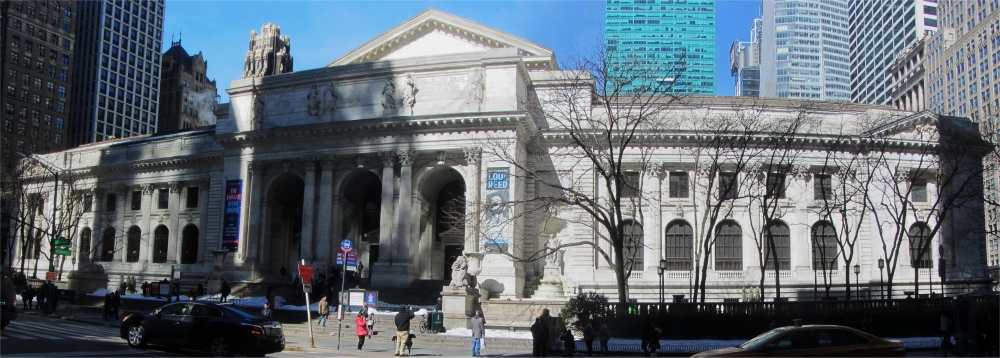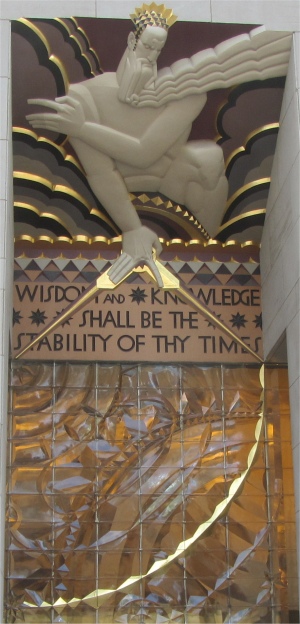A group of 20 of us were whisked off by a tour guide, a young woman of Japanese descent, but with the rapid vocabulary output that I had come to expect of New Yorkers. Her delivery was succinct, precise and knowledgeable. She began with an historical account of the building and the United Nations.
The United Nations was formed in 1945, to work for peace, economic and social well-being around the globe. This 18-acre East River site had been purchased through a donation of $8.5M donated by John D. Rockefeller. Wallace Harrison, the personal architectural adviser for the Rockefeller family and brother-in-law to a Rockefeller daughter, served as the Director of Planning for the Headquarters. He worked with international consultants to create the striking headquarters which was designed by Brazilian architect Oscar Niemeyer. The complex has served as the official headquarters of the United Nations since its completion in 1952, and has been declared international territory and belongs to the 193 Member States of the United Nations.
Our guide then took us on a brief journey through the corridors of international diplomacy, and talked us through the different United Nations organs:
- the General Assembly Hall
- the Security Council Chamber
- the Trusteeship Council Chamber
- the Economic and Social Council Chamber
We were able to enter Chambers where sessions were not in progress, and our guide chatted about the work and mandate of each of these main organs of the United Nations, especially in the realm of peace and security and economic and social development. In one chamber I was able to observe through a window a session in progress. The room was half occupied, some of the occupants were furiously writing notes, some typing away, and some poring over their mobile phones. Were the latter reporting back to base in real-time, or were they booking a table at their favourite restaurant for the evening. It seemed an informal setup with delegates coming and going all the time.
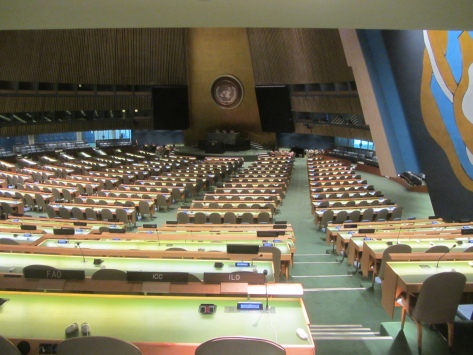
General Assembly Hall
|

Security Council Chamber
|
The General Assembly building holds the General Assembly Hall which has a seating capacity of 1,800. The General Assembly is the closest thing to a world parliament, where all 193 Members States of the Organization convene to discuss global issues.
The Conference Building faces the East River between the General Assembly Building and the Secretariat. This building holds the Security Council Chamber, which was a gift from Norway and was designed by the Norwegian architect Arnstein Arneberg. The oil canvas mural depicting a phoenix rising from its ashes by Norwegian artist Per Krogh hangs at the front of the room.
The 39-story Secretariat Building was completed in 1952. It houses offices for the Secretary General, the Under-Secretary-General for Legal Affairs and United Nations Legal Counsel, the Under-Secretary-General for Political Affairs and Office of Disarmament Affairs, and the Department for General Assembly and Conference Management.
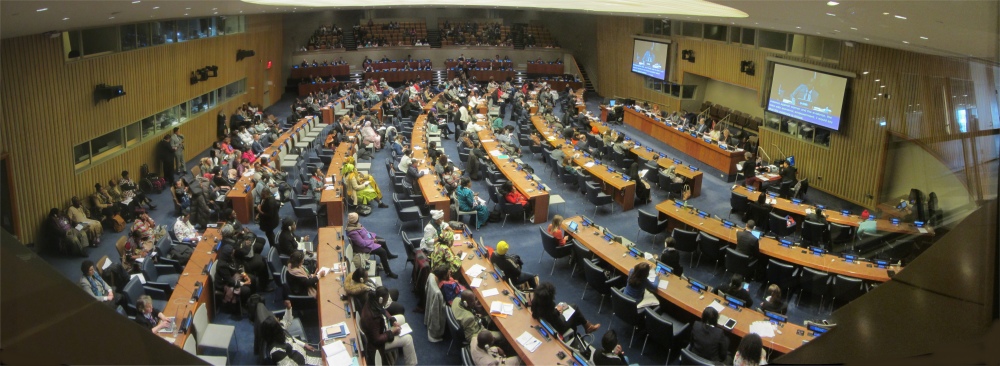
Chamber in Session
|
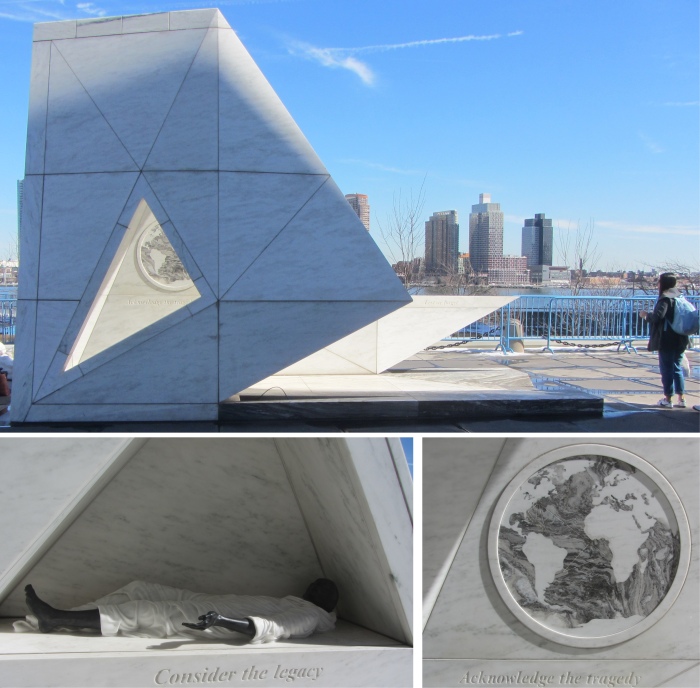
The Ark of Return
|
Many of these halls had been gifted, primarily by Scandinavian countries. I asked our guide why. "After the last World War, when the UN was formed, those countries were relatively less war ravaged and were not encumbered with huge war debts, so they donated the halls of their own accord," she replied. Over the years, Member States have donated works of art to the organisation to reflect its peaceful aims, such as the
"Golden Rule" mosaic based on a painting by Norman Rockwell, and a mural by the Spanish artist Jose Vela Zanetti.
In the human rights section of the tour, we had the opportunity to view the 30 articles of the Universal Declaration of Human Rights designed by Brazilian artist Octavio Roth. Our guide highlighted the work of the organisation in peacekeeping and in meeting targets set by the Millennium Development Goals. At the disarmament stop of the tour, we were shown around a gallery displaying remnants of the nuclear explosions in Nagasaki and Hiroshima (coins, bottles, and the statue of St. Agnes), and landmines of various types and shapes.
The tour, although only an hour long, had been heavily loaded on facts and stats, and there was a lot to take in. I left the building with a much greater appreciation of the wealth and breadth of the United Nations.
On the plaza outside, my eye was attracted to a couple of works. One was the Permanent Memorial to the Victims of Slavery and the Transatlantic Slave Trade.
The Ark of Return by architect Rodney Leon is the newest Memorial at the United Nations. It was inaugurated on 25th March 2015, on the occasion of the International Day of Remembrance of the Victims of Slavery and the Transatlantic Slave Trade. The Permanent Memorial invites people to contemplate the legacy of the slave trade and to fight against racism and prejudice today. Visitors can walk through the
Ark of Return to experience three elements:
Acknowledge the Tragedy, Consider the Legacy, Lest We Forget.
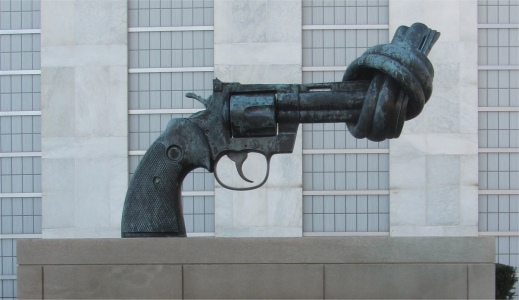
The Non-Violence Sculpture
|
Further along the plaza, on a plinth, stood
The Non-Violence Sculpture, also known as the
Knotted Gun sculpture, one of the first artworks seen at the UN on the outdoor Plaza at the UN Visitors Entrance. Swedish artist Carl Fredrik Reuterswärd, best known for this sculpture of a revolver with a knotted barrel, died on 3rd May 2016, aged 81. Reuterswärd made this sculpture after his friend, the singer and peace activist John Lennon, was shot dead in 1980. Yoko Ono asked him to commemorate Lennon. Initially, the sculpture was placed in the Strawberry Fields memorial in Central Park, New York, across the street from where Lennon and Yoko lived. In 1988, the Government of Luxembourg donated the bronze sculpture to the United Nations.
I headed back to 5th Avenue and made a beeline for the Rockefeller Centre. This acted as a magnet for thousands of locals and tourists alike, so I thought I'd investigate it myself; the centre has long been a hub of remarkable art, style, and entertainment, and I wanted to catch a flavour of that. However, the Rockefeller Centre is a large complex consisting of 19 high-rise commercial buildings covering 22 acres between 48th and 51st Streets. I was having a hard time navigating around the complex through the warren of underground linking tunnels. In the end I resorted to seeking out one of the guided tours.
Trying to get a consistent set of directions to the ticket booth for the guided tour was a mission in itself. The girl at the desk was rather user-unfriendly possessing negative courtesy levels. She reminded me of the girl I had encountered at the ticket booth to the
Berkeley Pit open-cast copper mine in Butte, Montana. Standing up to the girl's rudeness there had resulted in me in being hounded by the police.
But I received my ticket eventually, and joined a small group of other like-minded souls, all standing like naughty school children in the corner of a corridor. A young chap turned up, issued us all with receivers and headphones so we could hear him above the background din. He was kind enough to tell us in advance that being a New Yorker, he tended to speak rather quickly, and if any of us wanted anything repeated, all we had to do was ask. Within 10 minutes our group had shrunk by 50%, but I hung in with 3 Australian and 4 American stalwarts.

Channel Gardens and Sunken Garden
|
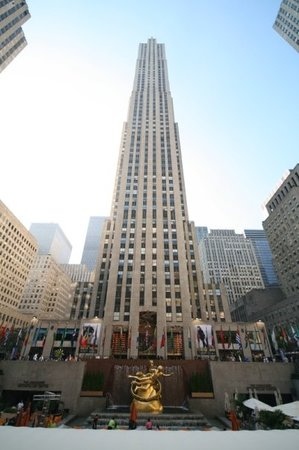
The GE Building
|
John Davison Rockefeller Jr. (1874 - 1960) was the legendary American financier and philanthropist who was a prominent member of the Rockefeller family. He was the only son among the five children of Standard Oil co-founder John D. Rockefeller and the father of the five famous Rockefeller brothers. John D. as he was known, strongly believed his inheritance should be used for the public good.

"Prometheus" : Paul Manship
|
Although John D. Rockefeller Jr. spent most of his life engaged in philanthropy, his single, defining business venture was the creation of the "city within a city". Constructed during the Great Depression's worst years, the project gainfully employed over 40,000 people. When Rockefeller Centre officially opened in May 1933, it held true to the developing team's belief that art was an act of good citizenship. 30 Rockefeller Plaza boasted a grand lobby decorated by accomplished European artists, Frank Brangwyn and José Maria Sert. During its first decade, the complex bustled with exciting tenants like the French bookstore, Librairie de France and the brand new publication News-Week (as it was originally called). And with a western edge devoted to entertainment, Rockefeller Centre has some real bragging rights, it was the site where John Hay Whitney and David O. Selznick decided to produce
Gone With the Wind and where the ever-adored Christmas Spectacular debuted. "Don't 'give the people what they want,'" said S.L. "Roxy" Rothafel, the man who created Radio City Music Hall. "Give 'em something better." Throughout the 1930s, the Rockefeller Centre steadily improved, including some accidental innovations like the Christmas Tree tradition in 1931 and the skating rink in 1936. By 1939, more than 125,000 people were visiting Rockefeller Centre daily; on its own, it would have been the 51st largest city in the U.S.
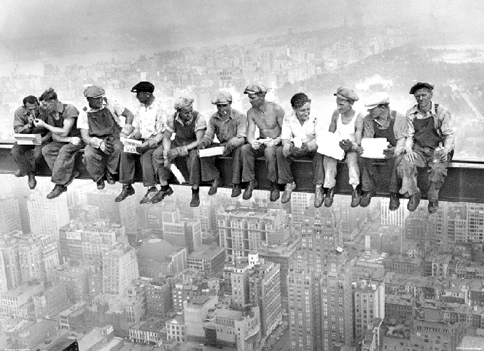
"Men on a Beam" : Charles C. Ebbets - 1932
|
The centre was the first commercial project to integrate gardens, dining, and shopping with office space. The number of buildings has grown to 19, though the newer buildings do not match the Art Deco elegance of the original 14 structures.
With our backs to St. Patrick's Cathedral, we strolled down the Channel Gardens, named after the English Channel since they separated the British and French buildings. This brought us to the Sunken Garden, a leafy outdoor cafe in the summer, but an ice skating rink in winter. Colourful flags of the United Nations surround the rink.
A 5.5m bronze gilded statue, by Paul Manship, of the Greek legend of the Titan
"Prometheus" recumbent, bringing fire to mankind, features prominently in the sunken plaza at the front of the Comcast Building. The model for Prometheus was Leonardo (Leon) Nole, and the inscription, a paraphrase from Aeschylus, on the granite wall behind, reads: "Prometheus, teacher in every art, brought the fire that hath proved to mortals a means to mighty ends." The pedestal represents Earth and the circle containing the signs of the zodiac represents the heavens.
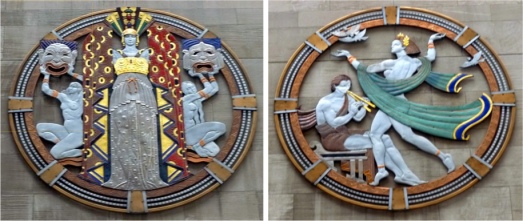
Radio City Music Hall Plaques
|
Towering above the sunken plaza stood the centrepiece of Rockefeller Centre, the 70-floor, 266m tall building at 30 Rockefeller Centre. The GE Building, alternatively known as the Comcast Building and 30 Rock, is the setting for the famous
"Men On A Beam" lunchtime atop a Skyscraper photograph, taken by Charles C. Ebbets in 1932 of construction workers sitting on a steel beam without safety harnesses eating lunch. Rockefeller wanted to ensure that no office was more than 8m from a window. This resulted in gradual setbacks being used as design features as the building rose.
The young guide took us out at street level to walk around the complex, informing us about the NBC Studios based in the centre, and as we passed by a large expanse of glass he indicated that behind it was the
Today Show studio. This morning TV show is broadcast live every weekday morning,
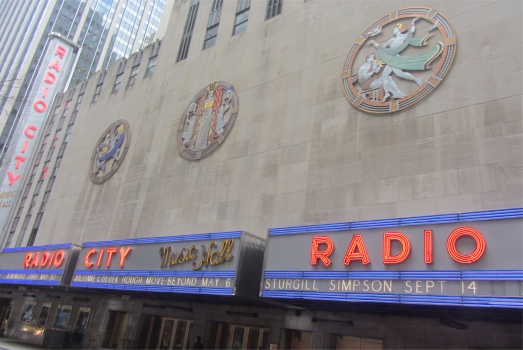
Radio City Music Hall
|
often with tourists peering through the window from the rear. We soon stumbled across an Art Deco masterpiece and former movie palace, the Radio City Music Hall, with its sleek lines of glowing neon. Three large stylized decorative plaques, placed high up on the south façade of Radio City Music Hall, represent the theatre's main activities. A collaboration between the sculptor and muralist Hildreth M. Meiere and famed metalworker Oscar B. Bach, they feature an exciting combination of metals, textures and colours that add playfulness to the plain limestone façade. Meiere first created a series of small, detailed studies; her final gouaches were used by Bach as a blueprint for fabrication in metal and coloration in enamel on a scale never before attempted.
Entering 1250 Avenue of the Americas loggia, we were suddenly confronted by a vast mosaic, the
"Intelligence Awakening Mankind" by Barry Faulkner. This mosaic of small glass tiles (tesserae) is composed of over one million glass tiles in two hundred and fifty colours, each hand-cut and hand-set. The work is a narrative concerning the triumph of knowledge over the evil of ignorance. The central figure of thought (intelligence) stands above the world, controlling the action in the mosaic; the two other powerful figures in this piece are spoken words and written words. Other figures symbolize creativity, ideas and intellectual efforts. The mosaic's message is that thought will propagate new knowledge and advance civilization. Hmmm... we still have some way to go

"Intelligence Awakening Mankind" : Barry Faulkner - 1933
|

"Industry and Agriculture" : Carl Paul Jennewein - 1937
|
At One Rockefeller Plaza main entrance, two heroic-sized carvings by Carl Paul Jennewein represent the commercial activities of
"Industry and Agriculture", depicting universal activities, not individuals. One figure holds a shovel, symbolizing industry, while the other holds a scythe and gestures to shafts of wheat, representing the harvest, or agriculture. It is a straightforward interpretation of workers and their work, a common Art Deco theme. The figures are strong and idealized, signifying the roots of prosperity in America and promoting its work ethic. Apparently when these images were first displayed, there was some controversy. The spade, half submerged in the earth, was interpreted by some as a hammer. Thus the two images were construed to be holding a hammer and sickle, with all the political associations at that time.
In the main lobby of 10 Rockefeller Plaza, a stunning mural depicting
"The History of Transportation" adorned the walls. With major commercial air travel taking off after World War II, Dean Cornwell was commissioned to create a mural depicting the advances of transportation. The mural spans three walls of the lobby, its parts subtitled Night Flight, New World Unity and Day Flight. In montage fashion, the murals begin with outdated modes of transportation important to the development of America. Other symbols include a falcon, goddesses, even race-car driver Eddie Rickenbacker, the then-president of Eastern Airlines (the primary tenant of this building). Cornwell had illustrations in leading magazines and was awarded a gold medal by the Architectural League of New York.
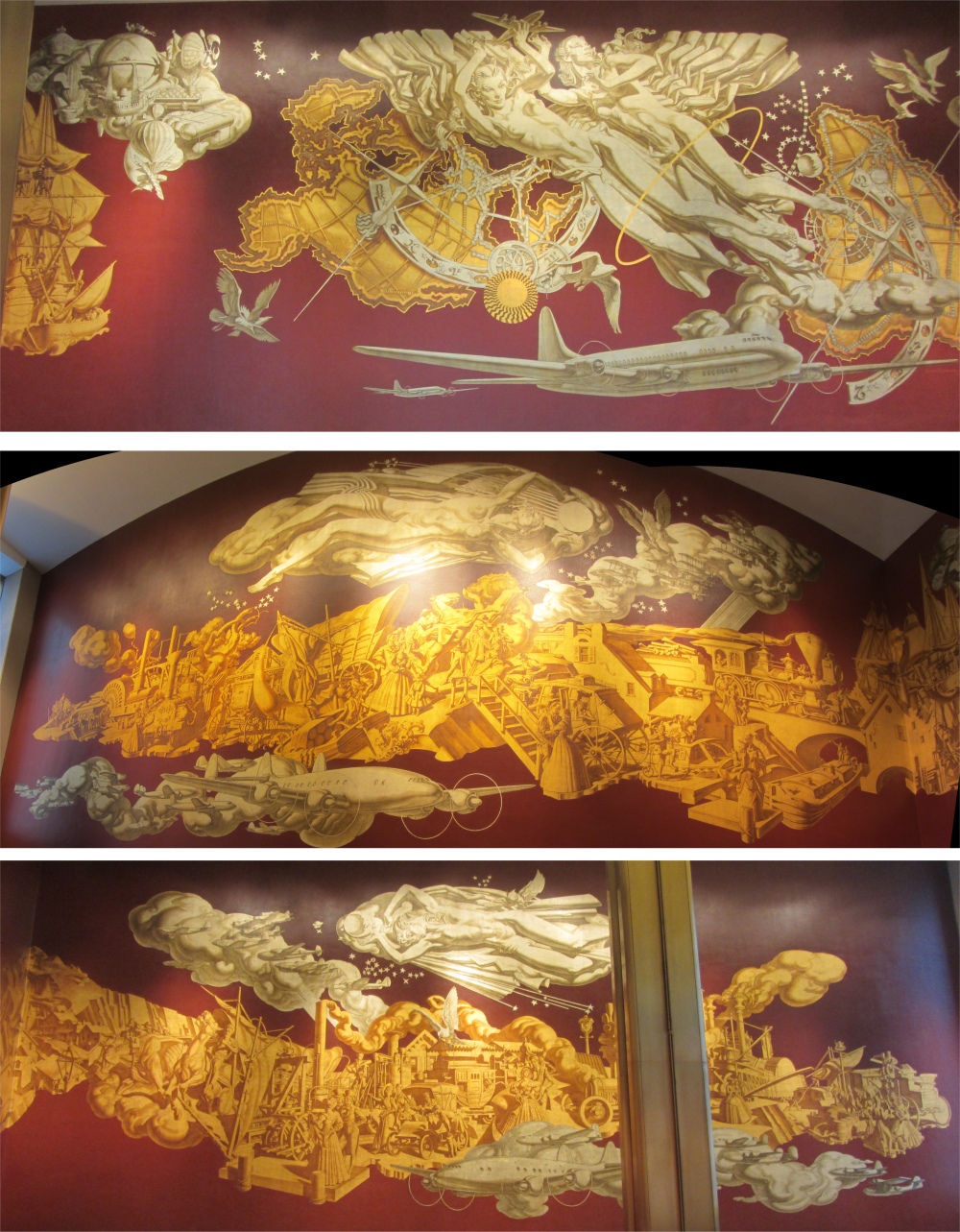
"The History of Transportation" : Dean Cornwell - 1946
|
Above the main entrance to 30 Rockefeller Plaza, an Art Deco icon,
"Wisdom" famously looms over the entrance to the main building of Rockefeller Center and can be seen from Fifth Avenue. Created by Lee Lawrie, one of America's foremost architectural sculptors, it is an impressive and imposing focal point. Wisdom is considered the creative power of the universe, and the figure's commanding slant, intimidating expression and biblical quote help convey his strength, impact and control over man. It is flanked by two other important works by Lawrie: Sound and Light.

"Wisdom" : Lee Lawrie - 1933
|

"News" : Isamu Noguchi - 1940
|
Soaring above the entrance to 50 Rockefeller Plaza, the dynamic plaque,
"News", symbolises the business of the building's former tenant, the Associated Press. One of the major Art Deco works in the Centre, it depicts five journalists focused on getting a scoop. AP's worldwide network is symbolised by diagonal radiating lines extending across the plaque. Intense angles and smooth planes create the fast-paced rhythm and energy of a newsroom.
"News" is the first heroic-sized sculpture ever cast in stainless steel and the only time Noguchi employed stainless steel as an artistic medium.
Above 45 Rockefeller Plaza Entrance the powerful sculptures
"Workmen of The Centre" stood. After immigrating to America, Gaston Lachaise abandoned his European academic training and began his own artistic explorations, favouring celebrations of the human body. Commissioned as a tribute to labour, these sculptures depict the workers as muscular, heroic male figures, idealizing both manual labour and supreme physical beings. Their strong shapes and curvilinear forms reveal the artist's knowledge of human anatomy and musculature. The same year they were installed, Lachaise was given a one-man show by the Museum of Modern Art.

"Workmen of The Centre" : Gaston Lachaise - 1935
|
Inside the Main Lobby of 30 Rockefeller Plaza we were confronted by a huge mural,
"American Progress", painted by Jose Maria Sert. Born in Barcelona, Sert spent his adult life living in Paris and was internationally famous as a mural painter. He was commissioned to paint this mural after the Rockefellers fired Diego Rivera, who offended them by making Lenin a principal figure on his original fresco. Sert's mural, the focal point of the lobby, depicts the development of America through the unity of brain and brawn. The three Graces symbolize man's intellectual activity, while Titans and men working represent men of action. Abraham Lincoln, Ralph Waldo Emerson and the Centre's skyscrapers also play prominent roles.
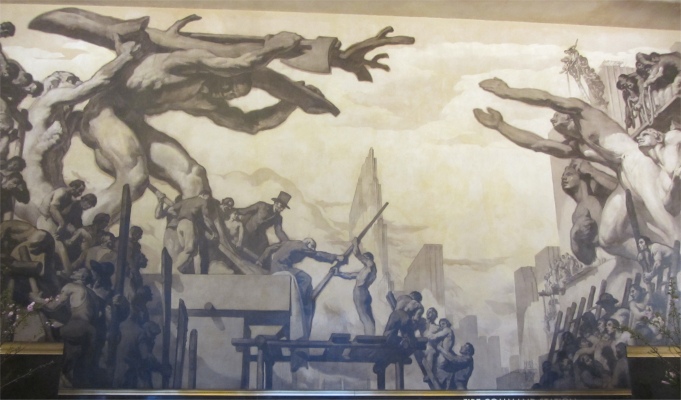
"American Progress" : Jose Maria Sert - 1937
|
We saw numerous other works of art on our tour, but I will leave it to the reader to go there and discover them for themselves. The young chap gave an insight into Rockefeller Jr: he was a devout Baptist, did not drink, smoke, gamble or womanise, and frowned upon unnecessary nudity which created some issues with some pieces of art in the centre. Despite his age, our guide was a very knowledgeable lad, and we left the tour a whole lot wiser than we would have been if we had not used his services.
This is one place where I would definitely recommend taking a guide to fully appreciate all it has to offer.
I wound down from my frantic touring of the sites by taking a hike all the way down 5th Avenue to its endpoint at Washington Square Park, passing the Flatiron Building on the way.
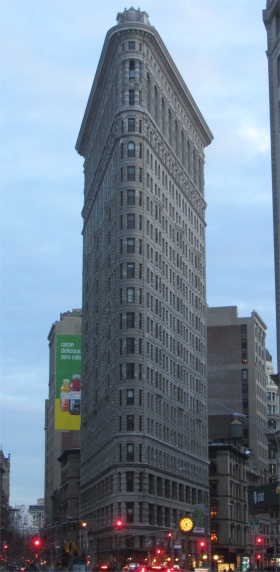
Flatiron Building
|
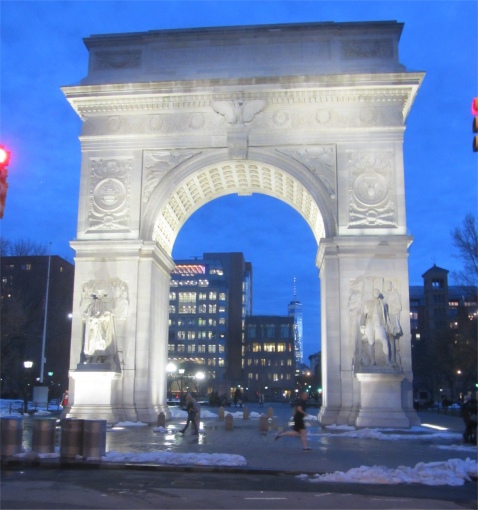
Washington Square Park
|
